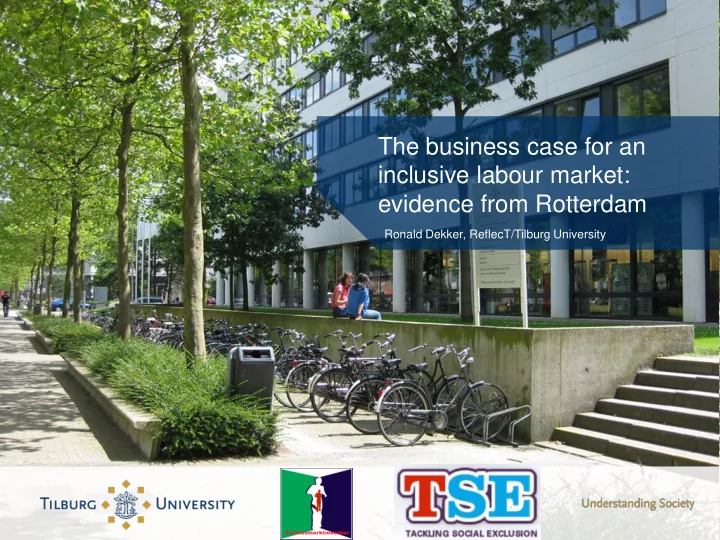

The business case for an inclusive labour market: evidence from Rotterdam Ronald Dekker, ReflecT/Tilburg University
Introduction • Bureau Arbeidsmarktmeester (‘Labour market superintendent’) • Tackling social inclusion by ‘inclusive labour market’ approach • My role • Describing ideas and concepts • Grounding these ideas and concepts in the academic literature • Ultimate goal: show that there is a ‘business case’ for an ‘inclusive labour market’
Inclusive labour market I • Different form of active labour market policy (ALMP) • Not only focuses on labour supply (workers and unemployed) • But also on labour demand: firms and other labour organisations • Caricatural picture: • traditional ‘Work first’ ALMP: ‘pushing people out of the benefit systems into the closed doors of firms’ • Inclusive labour market: ‘pulling people out of the benefit system by opening doors at firms’
Inclusive labour market II (Rotterdam) • Two main approaches by Bureau Arbeidsmarktmeester • ‘Human being management’ • Improve connection between labour markets and schools • Recognition of ‘mastery’ • Waiting for Work while Working (WWW) • Regionally/sectorally organised firms to provide employment security for workers and a flexible ‘pool’ of labour for firms within that region/sector • Also provide entry level employment and training for long term unemployed
Rotterdam • Leading in the ‘wrong rankings’ within the Netherlands • Benefit dependency • Bad health • School dropouts
Benefit recipients (% of population) Benefit recipients, 2010 25.00% 20.00% 15.00% 10.00% 5.00% Netherlands Rotterdam 0.00%
Bad health
School dropouts (% of school population)
Potential revenues of reduction of: Benefit dependency Benefit type Amount/month Unemployment benefit (Gross) 70% of last earned wage Disability benefit (WAO, old, gross) 70% of last earned wage Disability benefit (WIA, new, gross) 75/70% of last earned wage € 1.319,85 Social assistance (net, couple) € 659,93 Social assistance (net, single) € 923,90 Social assistance (net, single parent) € 1.424,40 Minimum wage (Gross, >23 years) If we would manage to reduce the number of benefit recipients by 10%, this would result in revenues amounting to at least 7700*12*659,93 ≈ 61 mln euros per annum
Potential revenues of reduction of: Health issues • There is a strong correlation between health status and unemployment/nonparticipation, but recent research has shown that this is mainly due to the fact that: • healthier individuals are more likely to be employed, and • less healthy individuals are more likely to be unemployed • In other words, the causal relation between unemployment and bad health is not very strong • So, reduction of benefit dependency is not likely to cause major reductions in health costs.
Potential revenues of reduction of: School dropouts • Recent research for the Netherlands has shown that raising the educational attainment level of ‘disadvantaged groups’ to the average could result in 49 billion euros in revenues, consisting of costs for education (-) and revenues in the form of wages, health (care) savings, crime reduction. • For Rotterdam this would amount to about 3.5% of this number: 1,7 billion euros • When reducing school dropout would result in reaching 1% of the goal above: this still would mean revenues in the order of magnitude of 170 million euros
To conclude • A conservative estimate of the revenues of an ‘inclusive labour market’ approach for Rotterdam would be around 230 million euros, including the wages for the people that start working • At the same time Rotterdam is spending around 137 million (2011) on ALMP • This suggests that there is a clear business case for the ‘inclusive labour market’ approach at the aggregate level
Questions/discussion • How to deal with the the problem: Costs (wages, risks) for some firms , revenues for society all firms • Think about ‘appropriation of social return’ • Using social security money for wage subsidies: issues of minimum wages and equal pay for equal work • Stimulate professional growth and transitions to ‘regular’ work
Recommend
More recommend